Temporal Analysis of GNSS-Based Precipitable Water Vapor during Rainy Days over the Philippines from 2015 to 2017
Abstract
:1. Introduction
2. Materials and Methods
2.1. Selection of Location
2.2. Selection of Experimental Data
2.3. Estimation of GNSS PWV
2.4. Evaluation of GNSS PWV
3. Discussion
3.1. Daily Variation of GNSS PWV and Rainfall
3.2. GNSS PWV in Rainy Days
4. Conclusions
Author Contributions
Funding
Acknowledgments
Conflicts of Interest
References
- Boutiouta, S.; Lahcene, A. Preliminary study of GNSS meteorology techniques in Algeria. Int. J. Remote Sens. 2013, 34, 5105–5118. [Google Scholar] [CrossRef]
- Choy, S.; Wang, C.-S.; Yeh, T.-K.; Dawson, J.; Jia, M.; Kuleshov, Y. Precipitable Water Vapor Estimates in the Australian Region from Ground-Based GPS Observations. Adv. Meteorol. 2015, 2015, 956481. [Google Scholar] [CrossRef] [Green Version]
- Realini, E.; Sato, K.; Tsuda, T.; Susilo, N.; Manik, T. An observation campaign of precipitable water vapor with multiple GPS receivers in western Java, Indonesia. Prog. Earth Planet. Sci. 2014, 1, 17. [Google Scholar] [CrossRef] [Green Version]
- Ross, R.J.; Elliott, W.P. Radiosonde-Based Northern Hemisphere Tropospheric Water Vapor Trends. J. Clim. 2001, 14, 1602–1612. [Google Scholar] [CrossRef]
- Carnicer, K.M.R.; Vallar, E.A.; Galvez, M.C.D. A Preliminary Study on the Precipitable Water Vapor (PWV) from the Davao Radiosonde Station for 2014. In Proceedings of the DLSU Congress, Manila, Philippines, 7–9 March 2016; p. 4. Available online: https://www.researchgate.net/publication/305729806_A_Preliminary_Study_on_the_Precipitable_Water_Vapor_PWV_from_the_Davao_Radiosonde_Station_for_2014 (accessed on 4 January 2022).
- Carnicer, K.M.R.; Castilla, R.M.; Vallar, E.A.; Galvez, M.C. On the variability of precipitable water vapor and its probabilistic modeling of precipitation occurrence in Davao city. Adv. Sci. Lett. 2017, 23, 1379–1383. [Google Scholar] [CrossRef]
- Bevis, M.; Businger, S.; Herring, T.A.; Rocken, C.; Anthes, R.A.; Ware, R.H. GPS meteorology: Remote sensing of atmospheric water vapor using the global positioning system. J. Geophys. Res. Atmos. 1992, 97, 15787–15801. [Google Scholar] [CrossRef]
- Macalalad, E.P.; Macalalad, R.V. Variation of GNSS-derived Precipitable Water Vapor Over Manila in 2017. In Proceedings of the 2019 6th International Conference on Space Science and Communication (IconSpace), Johor Bahru, Malaysia, 28–30 July 2019; IEEE: Piscataway, NJ, USA, 2019; pp. 235–238. [Google Scholar]
- Cruz, F.; Villarin, J. An Analysis of the Precipitable Water Vapor Observed over the PIMO GPS Station. Sci. Diliman 2001, 15, 84–87. [Google Scholar]
- Dodson, A.H.; Chen, W.; Penna, N.T.; Baker, H.C. GPS estimation of atmospheric water vapour from a moving platform. J. Atmos. Solar Terr. Phys. 2001, 63, 1331–1341. [Google Scholar] [CrossRef]
- Hattori, M.; Matsumoto, J.; Ogino, S.-Y.; Enomoto, T.; Miyoshi, T. The Impact of Additional Radiosonde Observations on the Analysis of Disturbances in the South China Sea during VPREX2010. Sci. Online Lett. Atmos. 2016, 12, 75–79. [Google Scholar] [CrossRef] [Green Version]
- Kubota, H.; Shirooka, R.; Matsumoto, J.; Cayanan, E.O.; Hilario, F.D. Tropical cyclone influence on the long-term variability of Philippine summer monsoon onset. Prog. Earth Planet. Sci. 2017, 4, 27. [Google Scholar] [CrossRef] [Green Version]
- Yuan, L.L.; Anthes, R.A.; Ware, R.H.; Rocken, C.; Bonner, W.D.; Bevis, M.G.; Businger, S. Sensing climate change using the global positioning system. J. Geophys. Res. Earth Surf. 1993, 98, 14925–14937. [Google Scholar] [CrossRef] [Green Version]
- Rocken, C.; Van Hove, T.; Ware, R. Near real-time GPS sensing of atmospheric water vapor. Geophys. Res. Lett. 1997, 24, 3221–3224. [Google Scholar] [CrossRef] [Green Version]
- Duan, J.; Bevis, M.; Fang, P.; Bock, Y.; Chiswell, S.; Businger, S.; Rocken, C.; Solheim, F.; van Hove, T.; Ware, R.; et al. GPS Meteorology: Direct Estimation of the Absolute Value of Precipitable Water. J. Appl. Meteorol. 1996, 35, 830–838. [Google Scholar] [CrossRef] [Green Version]
- Li, H.; Wang, X.; Wu, S.; Zhang, K.; Chen, X.; Qiu, C.; Zhang, S.; Zhang, J.; Xie, M.; Li, L. Development of an Improved Model for Prediction of Short-Term Heavy Precipitation Based on GNSS-Derived PWV. Remote Sens. 2020, 12, 4101. [Google Scholar] [CrossRef]
- Carnicer, K.M.R.; Vallar, E.A.; Galvez, M.C.D. On The Assimilation of GNSS PWV Measurements in Heavy to Torrential Rain Events in Davao City, Philippines. ARPN J. Eng. Appl. Sci. 2020, 15, 2188–2192. [Google Scholar] [CrossRef]
- Alshawaf, F.; Fuhrmann, T.; Knöpfler, A.; Luo, X.; Mayer, M.; Hinz, S.; Heck, B. Accurate Estimation of Atmospheric Water Vapor Using GNSS Observations and Surface Meteorological Data. IEEE Trans. Geosci. Remote Sens. 2015, 53, 3764–3771. [Google Scholar] [CrossRef]
- Isioye, O.A.; Combrinck, L.; Botai, J.O.; Munghemezulu, C. The Potential for Observing African Weather with GNSS Remote Sensing. Adv. Meteorol. 2015, 2015, 723071. [Google Scholar] [CrossRef]
- Coster, A.J.; Niell, A.E.; Solheim, F.S.; Mendes, V.B.; Toor, P.C.; Buchmann, K.P.; Upham, C.A. Measurements of Precipitable Water Vapor by GPS, Radiosondes, and a Microwave Water Vapor Radiometer. In Proceedings of the ION GPS-96, the 9th International Technical Meeting of the Satellite Division of the Institute of Navigation, Kansas City, MO, USA, 17–20 September 1996; pp. 625–634. [Google Scholar]
- Gurbuz, G.; Jin, S. Long-time variations of precipitable water vapour estimated from GPS, MODIS and radiosonde observations in Turkey. Int. J. Clim. 2017, 37, 5170–5180. [Google Scholar] [CrossRef]
- Zhang, Y.; Xu, J.; Yang, N.; Lan, P. Variability and Trends in Global Precipitable Water Vapor Retrieved from COSMIC Radio Occultation and Radiosonde Observations. Atmosphere 2018, 9, 174. [Google Scholar] [CrossRef] [Green Version]
- Tregoning, P.; Boers, R.; O’Brien, D.; Hendy, M. Accuracy of absolute precipitable water vapor estimates from GPS observations. J. Geophys. Res. Atmos. 1998, 103, 28701–28710. [Google Scholar] [CrossRef]
- Li, Z.; Muller, J.-P.; Cross, P. Comparison of precipitable water vapor derived from radiosonde, GPS, and Moderate-Resolution Imaging Spectroradiometer measurements. J. Geophys. Res. Atmos. 2003, 108. [Google Scholar] [CrossRef]
- Ohtani, R.; Naito, I. Comparisons of GPS-derived precipitable water vapors with radiosonde observations in Japan. J. Geophys. Res. Earth Surf. 2000, 105, 26917–26929. [Google Scholar] [CrossRef] [Green Version]
- Perdiguer-López, R.; Berné-Valero, J.L.; Garrido-Villén, N. Application of GNSS Methodologies to Obtain Precipitable Water Vapor (PWV) and Its Comparison with Radiosonde Data. Proceedings 2019, 19, 24. [Google Scholar] [CrossRef] [Green Version]
- Suparta, W.; Iskandar, A. Monitoring of GPS Water Vapor Variability During ENSO Events over the Borneo Region. Asian J. Earth Sci. 2012, 5, 88–95. [Google Scholar] [CrossRef]
- Suparta, W.; Iskandar, A.; Singh, M.S.J.; Ali, M.A.M.; Yatim, B.; Tangang, F. A study of El Niño-Southern oscillation impacts to the South China Sea region using ground-based GPS receiver. J. Phys. Conf. Ser. 2013, 423, 012043. [Google Scholar] [CrossRef] [Green Version]
- Suparta, W.; Iskandar, A.; Singh, M.S.J.; Ali, M.A.M.; Yatim, B.; Yatim, A.N.M. Analysis of GPS water vapor variability during the 2011 La Niña event over the western Pacific Ocean. Ann. Geophys. 2013, 56, R0330. [Google Scholar] [CrossRef]
- Villafuerte, M.Q., II; Juanillo, E.L.; Hilario, F.D. Climatic Insights on Academic Calendar Shift in the Philippines. Philipp. J. Sci. 2017, 146, 267–276. [Google Scholar]
- Matsumoto, J.; Olaguera, L.M.P.; Nguyen-Le, D.; Kubota, H.; Ii, M.Q.V. Climatological seasonal changes of wind and rainfall in the Philippines. Int. J. Clim. 2020, 40, 4843–4857. [Google Scholar] [CrossRef] [Green Version]
- Bagtasa, G. Contribution of Tropical Cyclones to Rainfall in the Philippines. J. Clim. 2017, 30, 3621–3633. [Google Scholar] [CrossRef]
- Bai, Z.; Feng, Y. GPS Water Vapor Estimation Using Interpolated Surface Meteorological Data from Australian Automatic Weather Stations. J. Glob. Position. Syst. 2003, 2, 83–89. [Google Scholar] [CrossRef]
- Feng, P.; Li, F.; Yan, J.; Zhang, F.; Barriot, J.-P. Assessment of the Accuracy of the Saastamoinen Model and VMF1/VMF3 Mapping Functions with Respect to Ray-Tracing from Radiosonde Data in the Framework of GNSS Meteorology. Remote Sens. 2020, 12, 3337. [Google Scholar] [CrossRef]
- Nakamura, H.; Koizumi, K.; Mannoji, N. Data Assimilation of GPS Precipitable Water Vapor into the JMA Mesoscale Numerical Weather Prediction Model and its Impact on Rainfall Forecasts. J. Meteorol. Soc. Jpn. Ser. II 2004, 82, 441–452. [Google Scholar] [CrossRef]
- Park, C.-G.; Baek, J.-H.; Cho, J.-H. Analysis on Characteristics of Radiosonde Bias Using GPS Precipitable Water Vapor. J. Astron. Space Sci. 2010, 27, 213–220. [Google Scholar] [CrossRef] [Green Version]
- Gui, K.; Che, H.; Chen, Q.; Zeng, Z.; Liu, H.; Wang, Y.; Zheng, Y.; Sun, T.; Liao, T.; Wang, H.; et al. Evaluation of radiosonde, MODIS-NIR-Clear, and AERONET precipitable water vapor using IGS ground-based GPS measurements over China. Atmos. Res. 2017, 197, 461–473. [Google Scholar] [CrossRef]
- He, Q.; Zhang, K.; Wu, S.; Zhao, Q.; Wang, X.; Shen, Z.; Li, L.; Wan, M.; Liu, X. Real-Time GNSS-Derived PWV for Typhoon Characterizations: A Case Study for Super Typhoon Mangkhut in Hong Kong. Remote Sens. 2020, 12, 104. [Google Scholar] [CrossRef] [Green Version]
- Shoji, Y.; Sato, K.; Yabuki, M.; Tsuda, T. Comparison of shipborne GNSS-derived precipitable water vapor with radiosonde in the western North Pacific and in the seas adjacent to Japan. Earth Planets Space 2017, 69, 153. [Google Scholar] [CrossRef]
- Maghrabi, A.H.; Alothman, A.O.A.; Fernandes, R.M.S.; Almutairi, M.M.; Aldosari, A.F.; Aldakhil, A.A.; Allehyani, B.I.; Aljabar, G.A.; Altilasi, M.I. Modelling and Validation of the Precipitable Water Vapour from Zenith Wet Delay using Radiosonde and GNSS Data in the Central Arabian Peninsula. Int. J. Environ. Sci. Nat. Resour. 2020, 25, 49–57. [Google Scholar] [CrossRef]
- Zhao, Q.; Yao, Y.; Yao, W. GPS-based PWV for precipitation forecasting and its application to a typhoon event. J. Atmos. Solar Terr. Phys. 2018, 167, 124–133. [Google Scholar] [CrossRef]
- Liu, C.; Zheng, N.; Zhang, K.; Liu, J. A New Method for Refining the GNSS-Derived Precipitable Water Vapor Map. Sensors 2019, 19, 698. [Google Scholar] [CrossRef] [Green Version]
- Yao, Y.; Shan, L.; Zhao, Q. Establishing a method of short-term rainfall forecasting based on GNSS-derived PWV and its application. Sci. Rep. 2017, 7, 12465. [Google Scholar] [CrossRef]
- Barindelli, S.; Realini, E.; Venuti, G.; Fermi, A.; Gatti, A. Detection of water vapor time variations associated with heavy rain in northern Italy by geodetic and low-cost GNSS receivers. Earth Planets Space 2018, 70, 1–18. [Google Scholar] [CrossRef] [Green Version]
- Pruppacher, H.R.; Klett, J.D. Microphysics of Clouds and Precipitation; Springer Science and Business Media: Berlin, Germany, 1996. [Google Scholar]
- Wang, Y.; Tang, L.; Zhang, J.; Gao, T.; Wang, Q.; Song, Y.; Hua, D. Investigation of Precipitable Water Vapor Obtained by Raman Lidar and Comprehensive Analyses with Meteorological Parameters in Xi’an. Remote Sens. 2018, 10, 967. [Google Scholar] [CrossRef] [Green Version]
- Zhang, H.; Yuan, Y.; Li, W.; Ou, J.; Li, Y.; Zhang, B. GPS PPP-derived precipitable water vapor retrieval based on T m /P s from multiple sources of meteorological data sets in China. J. Geophys. Res. Atmos. 2017, 122, 4165–4183. [Google Scholar] [CrossRef]
- Lagmay, A.M.F.; Bagtasa, G.; Crisologo, I.A.; Racoma, B.A.B.; David, C.P.C. Volcanoes magnify Metro Manila’s southwest monsoon rains and lethal floods. Front. Earth Sci. 2015, 2, 2. [Google Scholar] [CrossRef] [Green Version]
- Jiang, W.; Yuan, P.; Chen, H.; Cai, J.; Li, Z.; Chao, N.; Sneeuw, N. Annual variations of monsoon and drought detected by GPS: A case study in Yunnan, China. Sci. Rep. 2017, 7, 5874. [Google Scholar] [CrossRef]
- Renju, R.; Raju, C.S.; Mathew, N.; Antony, T.; Moorthy, K.K. Microwave radiometer observations of interannual water vapor variability and vertical structure over a tropical station. J. Geophys. Res. Atmos. 2015, 120, 4585–4599. [Google Scholar] [CrossRef]
- Olaguera, L.M.; Matsumoto, J.; Kubota, H.; Inoue, T.; Cayanan, E.O.; Hilario, F.D. Interdecadal Shifts in the Winter Monsoon Rainfall of the Philippines. Atmosphere 2018, 9, 464. [Google Scholar] [CrossRef] [Green Version]
- England, M.; McGregor, S.; Spence, P.; Meehl, G.A.; Timmermann, A.; Cai, W.; Gupta, A.S.; McPhaden, M.J.; Purich, A.; Santoso, A. Recent intensification of wind-driven circulation in the Pacific and the ongoing warming hiatus. Nat. Clim. Chang. 2014, 4, 222–227. [Google Scholar] [CrossRef]
- Raju, M.; Reddy, N.A.; Varma, S. Analytical study of MHD free convective, dissipative boundary layer flow past a porous vertical surface in the presence of thermal radiation, chemical reaction and constant suction. Ain Shams Eng. J. 2014, 5, 1361–1369. [Google Scholar] [CrossRef] [Green Version]
- Jalihal, C.; Srinivasan, J.; Chakraborty, A. Modulation of Indian monsoon by water vapor and cloud feedback over the past 22,000 years. Nat. Commun. 2019, 10, 5701. [Google Scholar] [CrossRef] [Green Version]
- Ferraro, A.J.; Lambert, F.H.; Collins, M.; Miles, G.M. Physical Mechanisms of Tropical Climate Feedbacks Investigated Using Temperature and Moisture Trends. J. Clim. 2015, 28, 8968–8987. [Google Scholar] [CrossRef]
- Soden, B.J.; Held, I.M. An Assessment of Climate Feedbacks in Coupled Ocean–Atmosphere Models. J. Clim. 2006, 19, 3354–3360. [Google Scholar] [CrossRef]
- Andrews, T.; Webb, M.J. The Dependence of Global Cloud and Lapse Rate Feedbacks on the Spatial Structure of Tropical Pacific Warming. J. Clim. 2018, 31, 641–654. [Google Scholar] [CrossRef]
- Soden, B.J.; Jackson, D.L.; Ramaswamy, V.; Schwarzkopf, M.D.; Huang, X. The Radiative Signature of Upper Tropospheric Moistening. Science 2005, 310, 841–844. [Google Scholar] [CrossRef] [PubMed] [Green Version]
- Lambert, F.H.; Ferraro, A.J.; Chadwick, R. Land–Ocean Shifts in Tropical Precipitation Linked to Surface Temperature and Humidity Change. J. Clim. 2017, 30, 4527–4545. [Google Scholar] [CrossRef] [Green Version]
- Ye, H.; Fetzer, E.J.; Wong, S.; Behrangi, A.; Olsen, E.T.; Cohen, J.; Lambrigtsen, B.H.; Chen, L. Impact of increased water vapor on precipitation efficiency over northern Eurasia. Geophys. Res. Lett. 2014, 41, 2941–2947. [Google Scholar] [CrossRef]
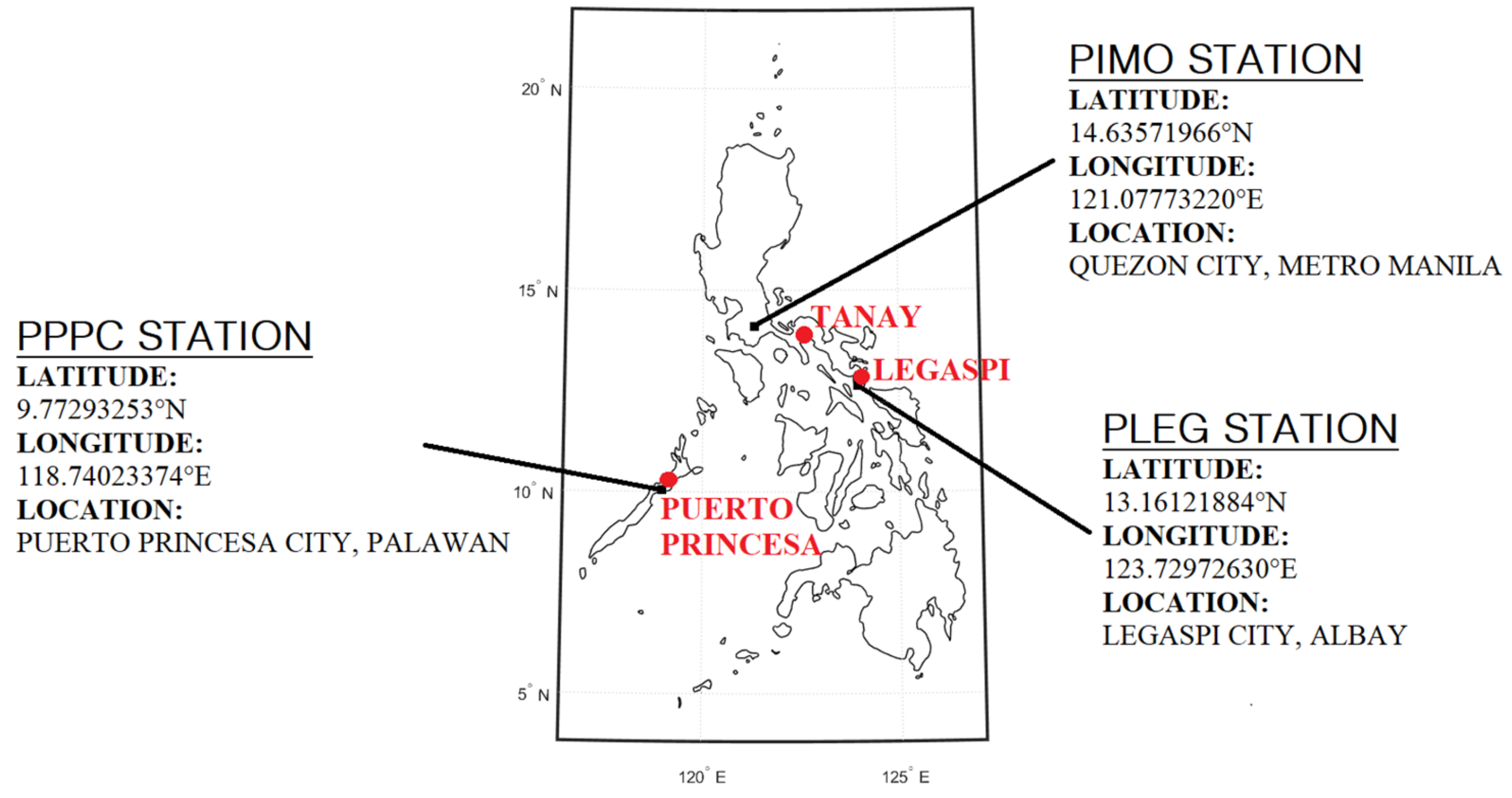
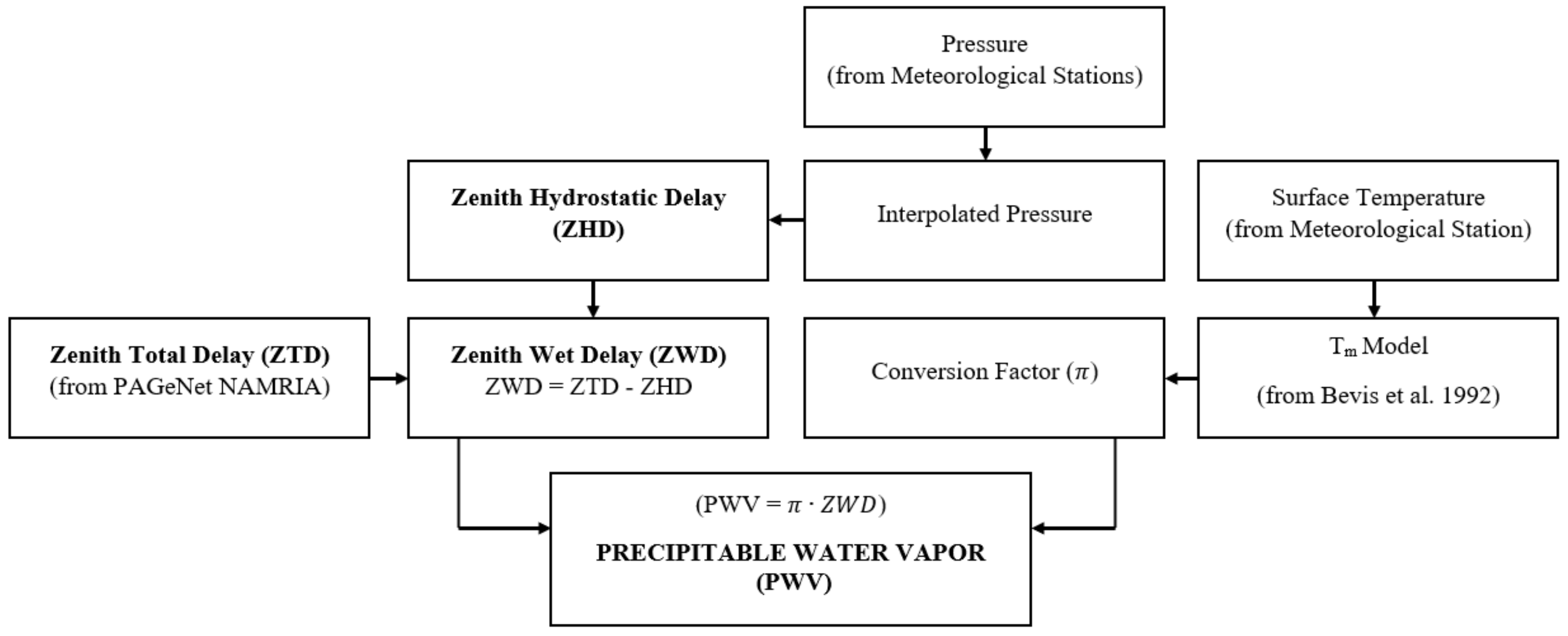
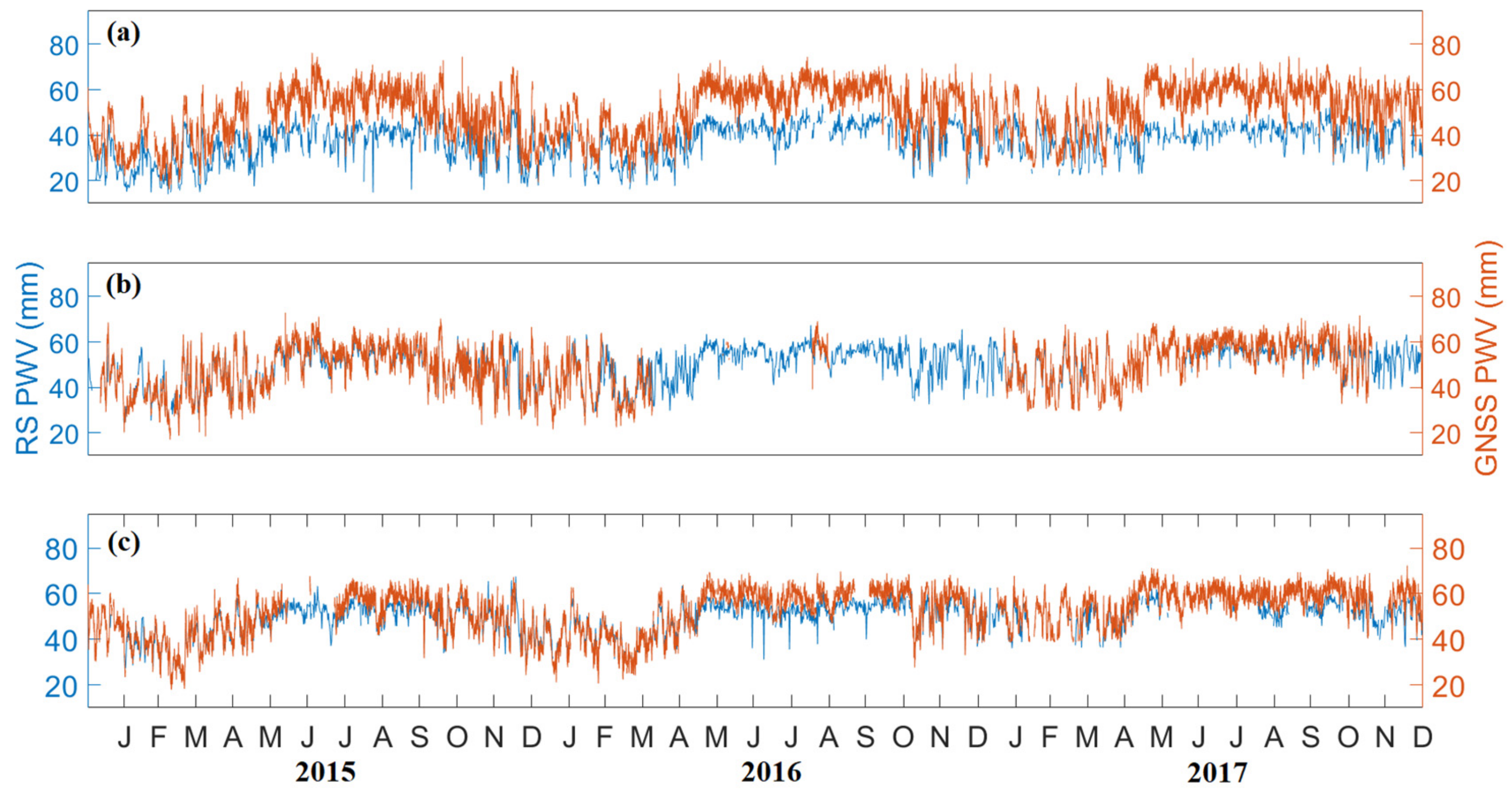


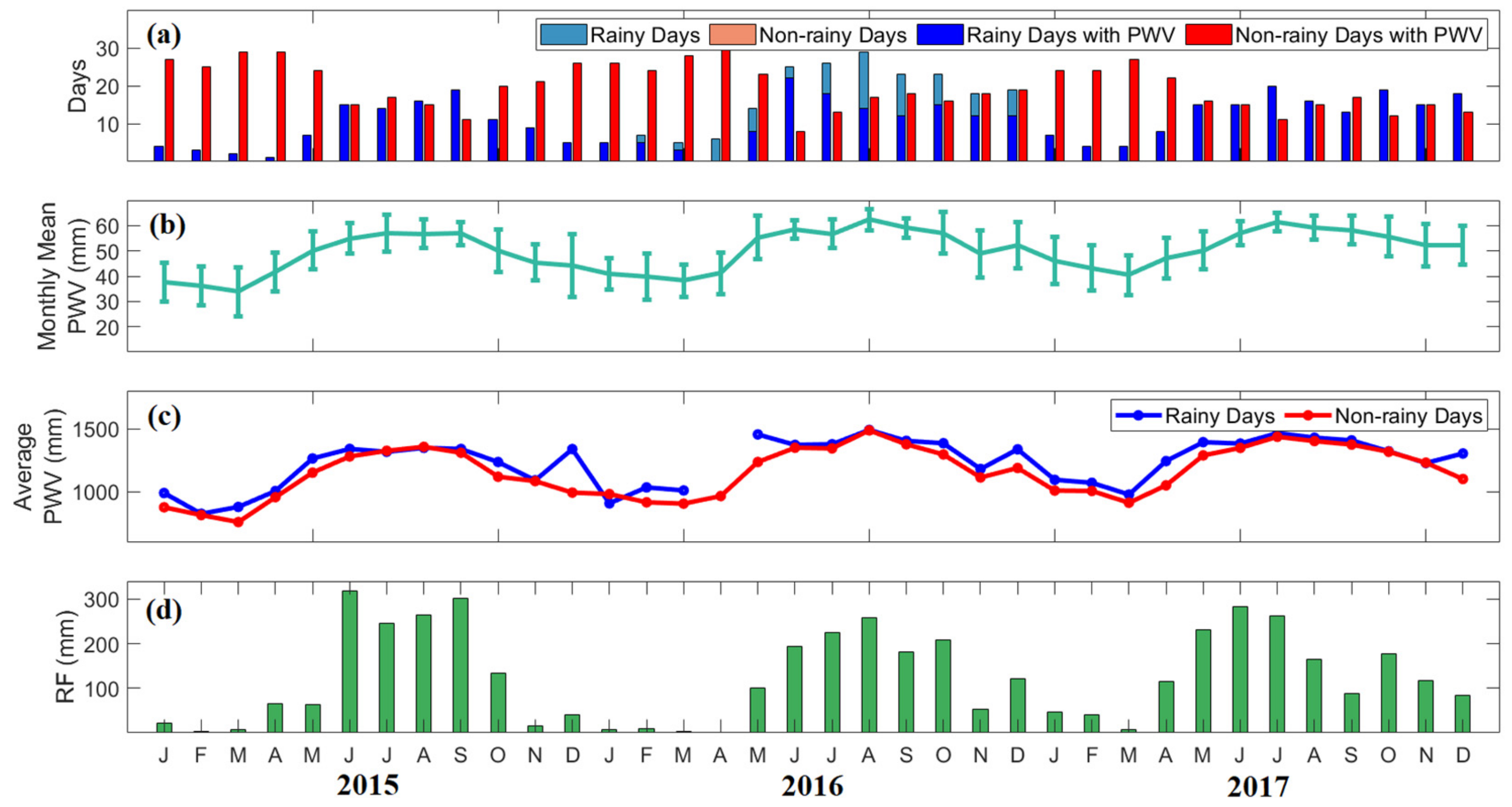
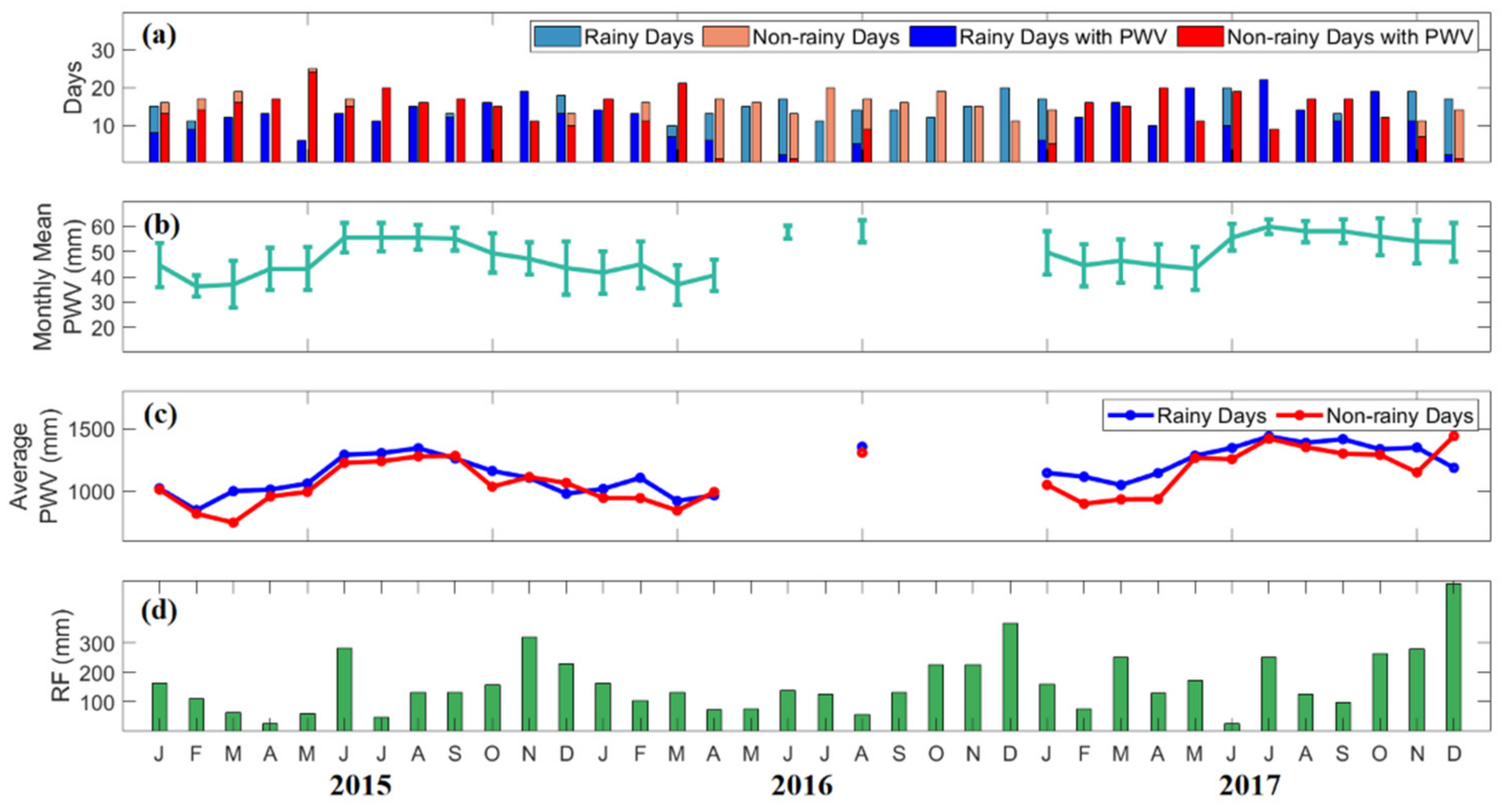

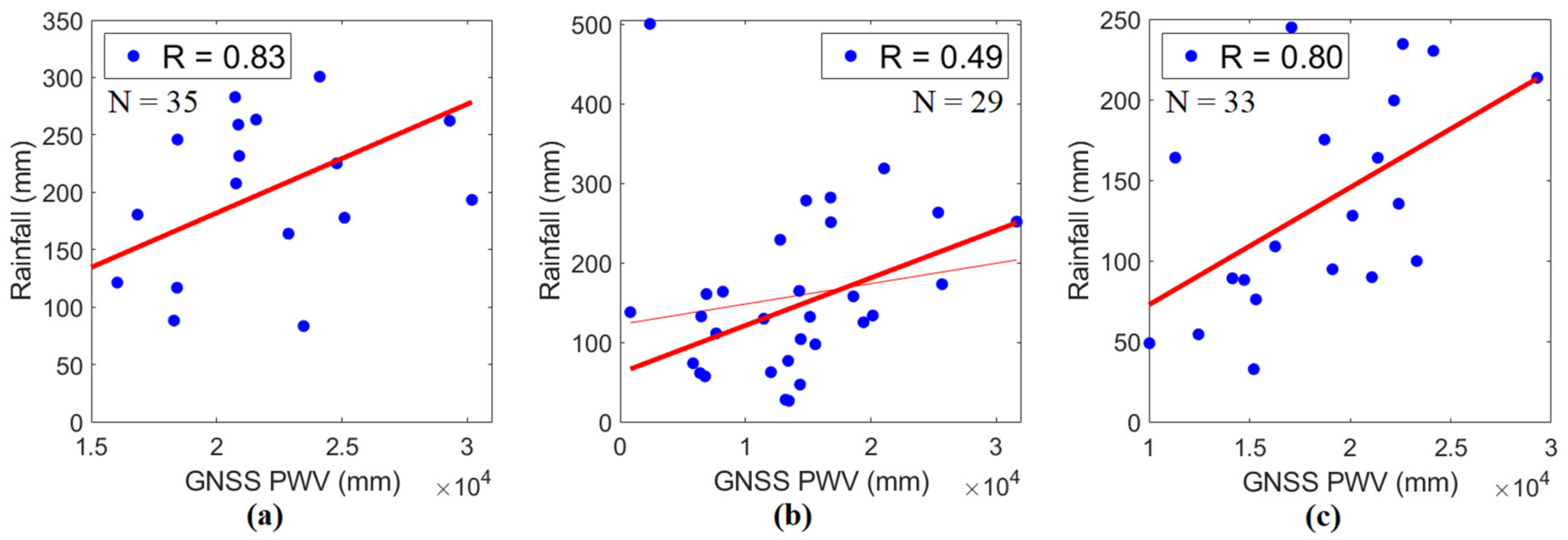
| GNSS and RS Stations | Distances | Height Differences | |
|---|---|---|---|
| 1 | PIMO | 32.96 km | 0.545 km |
| Tanay | |||
| 2 | PLEG | 1.15 km | 0.194 km |
| Legaspi | |||
| 3 | PPPC | 3.87 km | 0.053 km |
| Puerto Princesa | |||
| GNSS and Synoptic Stations | Distances | |
|---|---|---|
| 1 | PIMO | 3.75 km |
| Science Garden | ||
| 2 | PLEG | 1.18 km |
| Legaspi | ||
| 3 | PPPC | 3.82 km |
| Puerto Princesa | ||
Publisher’s Note: MDPI stays neutral with regard to jurisdictional claims in published maps and institutional affiliations. |
© 2022 by the authors. Licensee MDPI, Basel, Switzerland. This article is an open access article distributed under the terms and conditions of the Creative Commons Attribution (CC BY) license (https://creativecommons.org/licenses/by/4.0/).
Share and Cite
Domingo, A.L.S.; Macalalad, E.P. Temporal Analysis of GNSS-Based Precipitable Water Vapor during Rainy Days over the Philippines from 2015 to 2017. Atmosphere 2022, 13, 430. https://doi.org/10.3390/atmos13030430
Domingo ALS, Macalalad EP. Temporal Analysis of GNSS-Based Precipitable Water Vapor during Rainy Days over the Philippines from 2015 to 2017. Atmosphere. 2022; 13(3):430. https://doi.org/10.3390/atmos13030430
Chicago/Turabian StyleDomingo, Agana Louisse S., and Ernest P. Macalalad. 2022. "Temporal Analysis of GNSS-Based Precipitable Water Vapor during Rainy Days over the Philippines from 2015 to 2017" Atmosphere 13, no. 3: 430. https://doi.org/10.3390/atmos13030430







